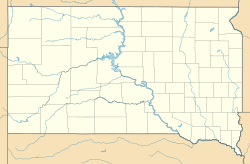South Dakota Department of Transportation Bridge No. 63-016-150 facts for kids
Quick facts for kids |
|
|
South Dakota Department of Transportation Bridge No. 63-016-150
|
|
| Nearest city | Marion, South Dakota |
|---|---|
| Area | less than one acre |
| Built | 1935 |
| Built by | Turner County Highway Dept. |
| Architectural style | Stone arch |
| MPS | Historic Bridges in South Dakota MPS |
| NRHP reference No. | 99001342 |
| Added to NRHP | November 19, 1999 |
This is the South Dakota Department of Transportation Bridge No. 63-016-150. It's a really old bridge in the countryside of Turner County, South Dakota. This special stone bridge was built in 1935. It was part of a big government plan called the New Deal that helped people find jobs during tough times. Because it's so well-preserved and important, it was added to the National Register of Historic Places in 1999.
Contents
About This Historic Bridge
This bridge, known as Bridge No. 63-016-150, is found in the western part of Turner County. It carries 283rd Street over a small stream. The bridge is made of stone and has two arches.
Bridge Design and Materials
The bridge is about 22 feet (6.7 meters) long. Its two arches are rounded and span about 7 feet 6 inches (2.29 meters) each. They rise about 9 feet (2.7 meters) above the stream. The bridge also has stone walls on its sides, called wing walls. There's a pointed part on the south side of the middle support, which helps cut through the water.
The bridge was built using local stone called quartzite fieldstone. Most of the stones are rough and laid in a random pattern. However, the parts that you see clearly, like the edges, were carefully cut and made square.
How the Bridge Was Built
This bridge is one of 180 stone arch bridges built in Turner County. They were all part of a federal jobs program during the New Deal era. This program was called the Federal Emergency Relief Administration (FERA).
Building Bridges During the New Deal
Turner County was able to build these stone bridges for less money than the usual steel bridges. This was because there were many skilled stone workers available. Also, the government helped pay their wages through the FERA program. The county was in charge of managing the work crews. They also provided all the building materials needed for the bridges.
This particular bridge was built in 1935 by a county crew. They followed a standard design from the state. It's one of only two bridges in the county that were built with FERA money. Other bridges were built later using funds from another program called the Works Progress Administration.



